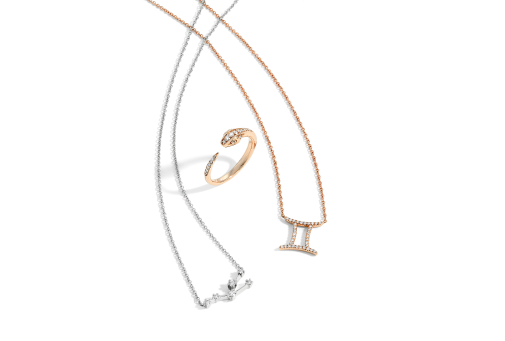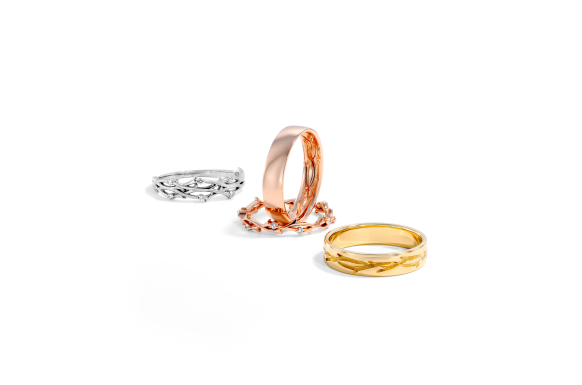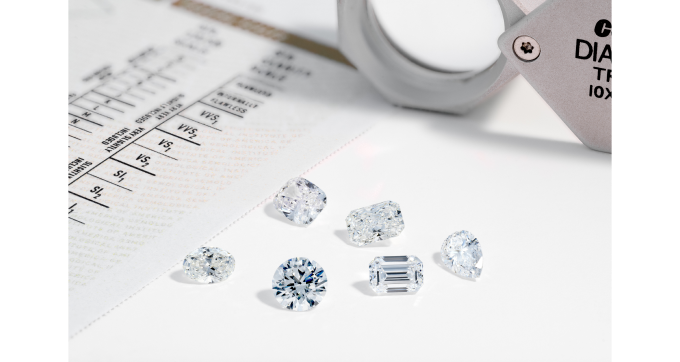Diamonds have always been an elegant, romantic, and expensive representation of love. And while they still are all of those things, lab-created diamonds have taken a little pressure off the price tag.
There are two types of diamonds, natural and lab-grown. These shiny gems are physically identical and both look darn good on your finger, so what exactly is the difference? Well, there's a world of difference in cost, sustainability, value, and values. If "bigger diamond, smaller price tag" is all you need to hear, then you can stop reading here. Go lab-grown. But in the event you'd like to know more, we've got you covered.
Shiny Science
There are two types of diamonds, earth mined and lab-grown. One of these diamonds has a high price tag, formed naturally billions of years ago and then torn from the earth (ouch!), creating quite the environmental impact. The other was grown in a lab with central AC and probably a coffee maker.
What is a Natural Diamond?
Natural diamonds are formed deep within the earth and then mined out.
The word diamond originates from the greek 'Adamas', meaning unconquerable or indestructible. In ancient times diamonds signified strength and were reserved for royalty. It is believed diamonds were first gathered from brooks and streams in India, where they were used for trading as early as the 4th century BC. By the 14th century, they were considered fashionable by Europe's elite.
Today, however, many people feel a natural diamond just isn't worth the price. A price, by the way, that has been artificially inflated for years thanks to diamond Cartels keeping a chokehold on the supply chain. Centuries of poor mining practices also leave consumers questioning if the lack of sustainability and excessive environmental impact is worth the price.
What is a Lab-Grown Diamond?
Lab-grown diamonds are exactly the same as natural diamonds. In fact, the only difference between the two is where they were formed. Visually there is no difference at all. Both lab and natural diamonds come in various shapes, sizes, colors, and clarities. Frankly, if you want to tell the difference between the two, you're going to need a specialist with professional equipment.
Now, let's be honest, there are a few notable differences between these two identical rocks, namely, lab-grown diamonds come with an extensive set of advantages. For one, they're a lot less expensive. I mean, this part is clutch. You can get a bigger diamond with more clarity and a better cut for a fraction of the price. Secondly, they're better for the environment, more sustainable, and there's no ethical dilemma looming overhead. Instead of who knows who digging a giant hole in the earth, a nice man in a lab coat does some science at his good-paying job and goes home to his family.
Truthfully, back in the day, natural diamonds were better. But times have changed, technology has improved, and so have lab diamonds. You'd be hardpressed to find a disadvantage.
Tech Talk
Ah, the science of it all. Lab diamonds first became available commercially in the 1950s thanks to General Electric using a high-pressure method (HPHT) which is mainly used today to make industrial diamonds. Another way to form lab diamonds is through a Chemical Vapor Disposition (CVD).
The diamonds produced in both processes are identical to natural diamonds down to the individual atom. They have the same sparkle, the same hardness, the same minor imperfections and inclusions that make them unique. It's the same diamond.
The only real difference is that sometimes diamonds found in nature contain trace amounts of nitrogen which gemologists can look for to identify them, and lab diamonds do not.
How in Earth? - The Formation of Diamonds
Natural diamonds are old, like older than life on earth old. These stones formed around 100 miles beneath the surface of the earth billions of years ago. Carbon atoms were crushed into crystals by the extreme heat and pressure below, creating diamonds. They also happen to be the hardest naturally occurring substance on earth… and they're shiny!
What's the Diff? Natural vs. Lab Diamonds
Check it out. There are two types of diamonds. They have the same brilliance, fire, and shiny, gorgeous appeal, because they are, well, identical.
So what's the difference?
The big differences come down to price and production, and both origins tell very different stories. Natural diamonds are mined. They come from massive operations that dig and sift through literal tons of earth to find each stone. Seriously, an average of 1,700 tons of dirt is displaced to find a single 1ct diamond.
Big diamond companies would have you believe these diamonds are rare and therefore valuable. But the truth is diamond cartels have artificially inflated the prices, and those same big diamond companies hoard billions of stones to drive up prices even further.
When it comes to lab-grown diamonds, the price is directly tied to the cost of production, making them super affordable in comparison. Additionally, lab diamonds are a sustainably produced resource. A constant supply makes for a consistent market value that is not artificially inflated.
As the lab-grown diamond market expands, that price has dropped. Today lab diamonds can be anywhere from 30-60% less expensive than mined diamonds.
Let's dispel a few nasty rumors. There is a misconception that mined diamonds hold their value. This is generally untrue until you've spent upwards of 25-30 thousand dollars on a diamond. Even then, you lose a lot when you resell a diamond.
In the case of a very rare diamond, we're talking like 10ct here, the value might hold, but you'd STILL be reselling it for up to 50% less than you paid for it. The truth is that most people are better off with lab diamonds. Heck, if you are going to lose at least 50% reselling a diamond, you might as well save it in the first place and get yourself a huge science diamond.
So Many Choices, So Few Fingers
There are many choices when it comes to what to buy, and a case can be made for both lab-created and natural diamonds.
The Natural Choice
Some couples love the romance and the tradition of a natural diamond. Others love to wonder about the unique prehistoric stone that existed long before life and will be here long afterward. The truth is some people don’t mind spending a little (or a lot) extra cash to get the rock they feel has more value. Is this the wrong choice? Not at all, it’s totally up to you.
The Modern Alternative
On the other hand, many couples prefer the value and sustainability of a lab-created diamond. Young couples (or really anyone) often go for the lab look and save a pretty nice chunk of change. Why not get yourself a big ole rock for a fraction of the price?
Some prefer that nature be left to nature and feel lab diamonds are a favorable alternative to supporting diamond mining. Because lab diamonds are indistinguishable from the natural alternative, many feel there is no reason to pay more for something plucked from the ground instead of picked from a lab.
The bottom line is if you chose a lab diamond you’re going to be able to cover a lot more bases with the same budget to get the size, shape, and sparkle of your dreams. Still can't decide? Let's weigh the pros and cons.
Natural Vs Lab Diamonds - Pros and Cons
Supply and Diamond
Supply and demand it's what makes the world go round, and the prices go up.
Many people would have you believe that mined diamonds are a rare and finite resource, and that's what makes them so dang valuable. The truth is it's all about controlling the supply.
In 2000 it was reported that DeBeers alone had 5.2 BILLION dollars worth of diamonds just sitting in a stockpile. They are just one of many big diamond companies with hordes of diamonds they don't even want to sell, simply because it makes them seem rare.
That's honestly not even the biggest bummer about the situation. What if one day DeBeers decided to liquidate their diamond stash? That pricy natural diamond you spent your savings could be worth nada faster than you can say, "shiny." The point is supply and demand are set artificially, so don't place too much value on today's price.
This just doesn't happen with lab-created diamonds. Lab diamonds also take time and resources to create, but they're being made constantly, and there are more than enough produced every year to meet the demand.
Lab diamonds cost less than mined diamonds, yes, but that's not saying anything about the quality. Both diamonds are graded with the same standards in mind. Meaning you can get a better diamond for less when you choose lab-grown.
Value and Values
Whether you are talking about the monetary value or moral values, mined diamonds are a touchy subject. Thats due in large part to the dark history of diamond mining, a history that is not a part of the lab diamond story.
In the past natural diamonds were believed to be a great store of wealth and a solid investment. That is simply not the case in today's market, as mined diamond pricing is exclusively set by large retailers. We pay what they say.
There are also both ethical and environmental concerns about mined diamonds that simply aren't a factor when it comes to lab-grown diamonds. That's why more and more couples are deciding to go for the ethical and sustainable choice of a lab-grown diamond. Some couples may prefer the symbolism of a natural diamond, placing their value in tradition. Others may put more value on the size of a stone, favoring lab diamonds since they make it possible to choose a larger stone for less.
Still, others place the value in passing a stone down through generations, and in this case, isn't who the diamond came from more important than where it came from?
The Science of Sustainability
These days sustainability is a top priority for many people, and most industries are doing what they can to keep production up and their carbon footprint down. The diamond industry is no different.
Ethics
Ethically speaking, the diamond industry has come a long way. Thanks to the Kimberly Process, 99.8% of diamonds and all major diamond producers are now required to make sure their diamonds are responsibly mined.
Over the past 100 years, the mining industry has seen some of the most brutal conditions for its laborers, along with the irreparable damage to the earth they mine. While the Kimberly Process was passed in 2003, there is still some debate over how well companies are sticking to this agreement.
With Keyzar, there is no debate. Keyzar only works with ethical providers, period. While lab diamonds still require substantial time and labor to create because they are made in a lab, there is no question about their ethical origin.
Sustainability
Diamond mining, like any mining, is hard on the earth. Around 100,000 tons of rock are displaced, looking for a single 1ct flawless diamond.
Mining companies are making an effort to shrink their carbon footprint by using recycled water and even wind power. And while larger mining companies have pledged to protect the environment, the act of mining itself is inherently destructive to the earth itself.
It should go without saying that a diamond grown in a lab is more kind to the planet than one torn from the ground.
While the creation of lab diamonds does use a good deal of energy, the man-made nature of lab diamonds makes them a renewable resource creating more long-term, ethically sustainable diamonds.
Certified Shiny
Whether you're looking for a mined or lab diamond, an internally flawless and excellent cut diamond is a thing of absolute perfection and usually has a price tag to match.
Finding a colorless diamond with no visual inclusions is extremely rare since both types of a diamond usually have a varying number of inclusions that affect the clarity. A diamonds certification report will tell you everything you need to know to find the best diamond at the right price. But just what does all this technical jargon mean? Here's what you need to know:
Rock Report
Diamond grading reports will contain information regarding a diamond's cut, color, clarity, and carat weight.
In the case of lab diamonds, the growth process (HPHT or CVD) is also identified here. Looking at these reports can be overwhelming, but there are a few details that are way more important than anything else, so let's focus on the 4c's.
1. Cut is by far the most important factor. It controls a diamond's brilliance and sparkle.
2. Clarity tells us how many visible inclusions are in a diamond.
Clarity is particularly important in an Asscher, or emerald cut, as the square shape is much more likely to reveal flaws that might be hidden in a round-cut diamond. In these cuts, you'll want to go with something in the VS2 or better range. Round diamonds vary by carat weight, but for a 1ct round brilliant, something in the VS1 or VS2 range will look great.
3. Color refers to how colorless or yellow a diamond is on a scale of D (colorless) to Z (light yellow or brown). A completely colorless diamond is rated D, E, or F on the color scale. These diamonds will be much more expensive than one a bit further down the scale.
Consider the setting and gold color. When setting a round diamond in white gold, anything rated J or above on the color scale will appear colorless in the setting. If you choose a yellow or rose gold setting, a stone with a more visible color may work just fine.
4. Carat refers to the weight of the diamond. Diamonds weighing 1ct, 0.75ct, 0.5ct, etc., will cost more than diamonds that are just slightly under that weight.
Conclusion
Visually, there is no difference between these two diamonds. Atomically, they are identical. The fundamental differences come down to price and sustainability. Lab diamonds offer an ethical and sustainable option that's better for the planet and your wallet. Old fashioned mined diamonds have an old-world charm and a colorful backstory. So which rock will you rock?






